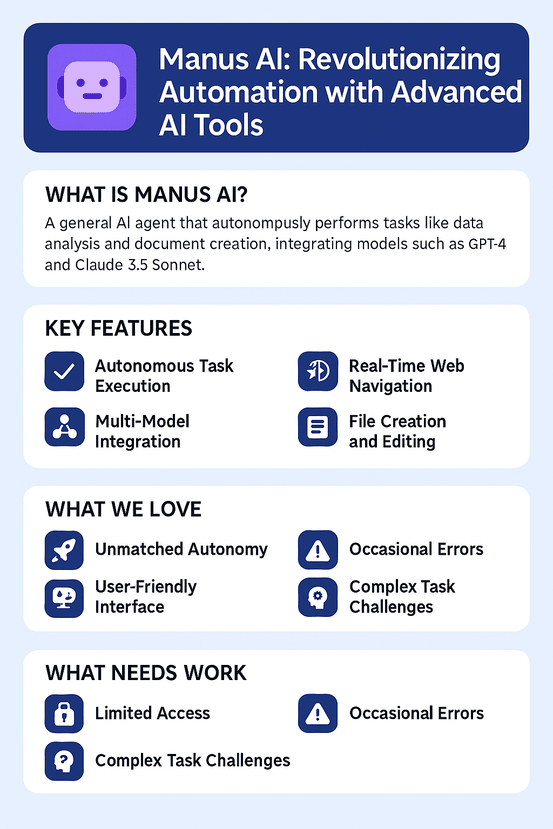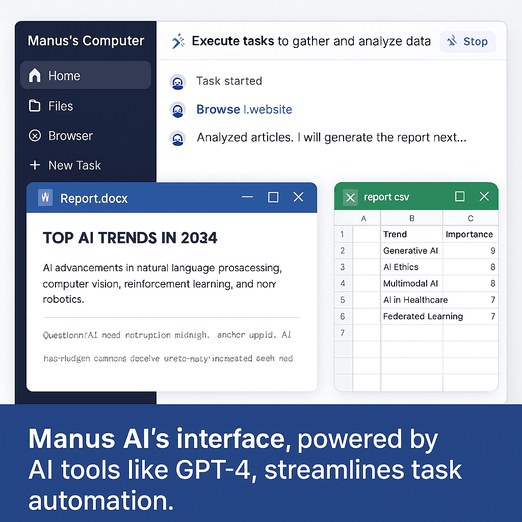What Is Manus AI?
Manus AI, developed by the Wuhan-based startup Butterfly Effect, is a pioneering general AI agent designed to autonomously execute complex tasks across various domains, setting it apart from traditional conversational AI models like ChatGPT. Launched in 2025, it integrates multiple AI models, including Anthropic’s Claude 3.5 Sonnet and fine-tuned versions of Alibaba’s Qwen, to perform tasks like data analysis, document creation, and process automation with minimal human intervention. Its intuitive interface and real-time web navigation capabilities make it a standout in the AI tools ecosystem, promising significant productivity enhancements for businesses and individuals [,].
Revolutionizing Content Creation with Manus AI and Veo 3 Integration
The latest Manus AI update, powered by the Veo 3 model, revolutionizes content creation by turning complex research and raw data into polished videos and interactive websites—instantly. With native audio and automation features, professionals can now create stunning educational, marketing, or research content without coding skills. Manus AI simplifies reporting by analyzing trends and generating clear, actionable insights. It also streamlines workflows by automating website creation with dynamic elements like graphs and videos. Whether you’re an educator, marketer, or analyst, this integration bridges the gap between data and storytelling. It’s not just faster—it’s smarter content creation.
Key Features of Manus AI
- Autonomous Task Execution: Manus AI independently completes tasks like generating reports or analyzing data, leveraging OpenAI’s GPT-4 for natural language processing and decision-making [].
- Real-Time Web Navigation: It browses the web to gather data, powered by advanced search algorithms akin to those in LangChain, ensuring up-to-date information [].
- Multi-Model Integration: Combines models like Claude 3.5 Sonnet and Qwen for enhanced reasoning, offering robust task-handling capabilities [].
- File Creation and Editing: Creates and edits documents in formats like Word and Excel, streamlining workflows with AI tools like Hugging Face Transformers for content generation [].
- Continuous Learning: Adapts to user preferences, such as report formats, using reinforcement learning techniques similar to those in AI research platforms [].
- Interactive Interface: Features “Manus’s Computer” window, allowing users to monitor and intervene in tasks, augmented by real-time feedback loops [].
Real-World Use Cases for Manus AI
- Tech Journalism: Manus AI compiles lists of reporters with their notable works, using GPT-4 to summarize and verify information, as tested by MIT Technology Review [].
- Real Estate: It searches for property listings, employing LangChain-like tools to filter and analyze data, aiding agencies in streamlining client searches [].
- Recruitment: Automates resume screening and candidate analysis, integrating Hugging Face Embeddings for skill matching, used by HR firms for efficient hiring [].
- Academic Research: Converts complex PDFs into presentations, leveraging AI tools like OpenAI API for summarization, benefiting researchers in universities [].
What We Love About Manus AI

- Unmatched Autonomy: Executes tasks end-to-end, reducing manual effort, powered by advanced AI tools like GPT-4 [].
- Versatile Applications: Handles diverse tasks from analytics to creative outputs, enhanced by multi-model integration [].
- User-Friendly Interface: The “Manus’s Computer” window offers transparency and control, a standout feature among free AI tools [].
- High Performance: Outperforms GPT-4 in GAIA benchmarks, showcasing superior real-world problem-solving [].
Image Caption: Manus AI’s interface, powered by AI tools like GPT-4, streamlines task automation.
What Needs Work
- Limited Access: Currently in beta with restricted availability, limiting widespread adoption; broader API access like OpenAI’s could help [].
- Occasional Errors: May cut corners or make incorrect assumptions, requiring feedback; AI tools like Pinecone could improve accuracy [].
- Complex Task Challenges: Struggles with highly dynamic tasks; enhanced reinforcement learning could address this [].
- Transparency Gaps: Ethical and algorithmic transparency needs improvement; AI ethics frameworks could guide development [].
Relevant Comparisons
| Feature | Manus AI | ChatGPT Operator | xAI’s Grok |
|---|---|---|---|
| Performance | Outperforms GPT-4 in GAIA benchmarks [] | Strong but less autonomous [] | Conversational focus, less task execution [] |
| AI Integration | Uses Claude 3.5, Qwen, GPT-4 [] | Relies on GPT-4, limited multi-model [] | Uses proprietary models, no multi-model [] |
| Ecosystem | Integrates with external tools [] | Limited to OpenAI ecosystem [] | X platform integration [] |
- Manus AI: Excels in autonomy and multi-model integration, ideal for complex tasks.
- ChatGPT Operator: Strong conversational AI but less autonomous, relying heavily on OpenAI’s GPT-4.
- Grok: Focused on conversational insights, lacks Manus’s task execution and multi-model support.
Pricing
Manus AI is currently in a limited beta phase, accessible via waitlist on monica.im, with no public pricing details available. Priority access is granted for specific use cases, suggesting a potential subscription or pay-as-you-go model post-beta. Unlike free AI tools like ChatGPT’s free tier, Manus AI’s advanced features may incur costs similar to premium plans (e.g., ChatGPT Plus at $20/month). For updates, check manus.im [,].
Final Verdict
Manus AI is a game-changer for professionals seeking autonomous task execution, leveraging AI tools like GPT-4 and Claude 3.5 to enhance productivity. Despite beta limitations and occasional errors, its innovative approach makes it a must-have for tech-savvy businesses and researchers. Rating: 4.5/5.
